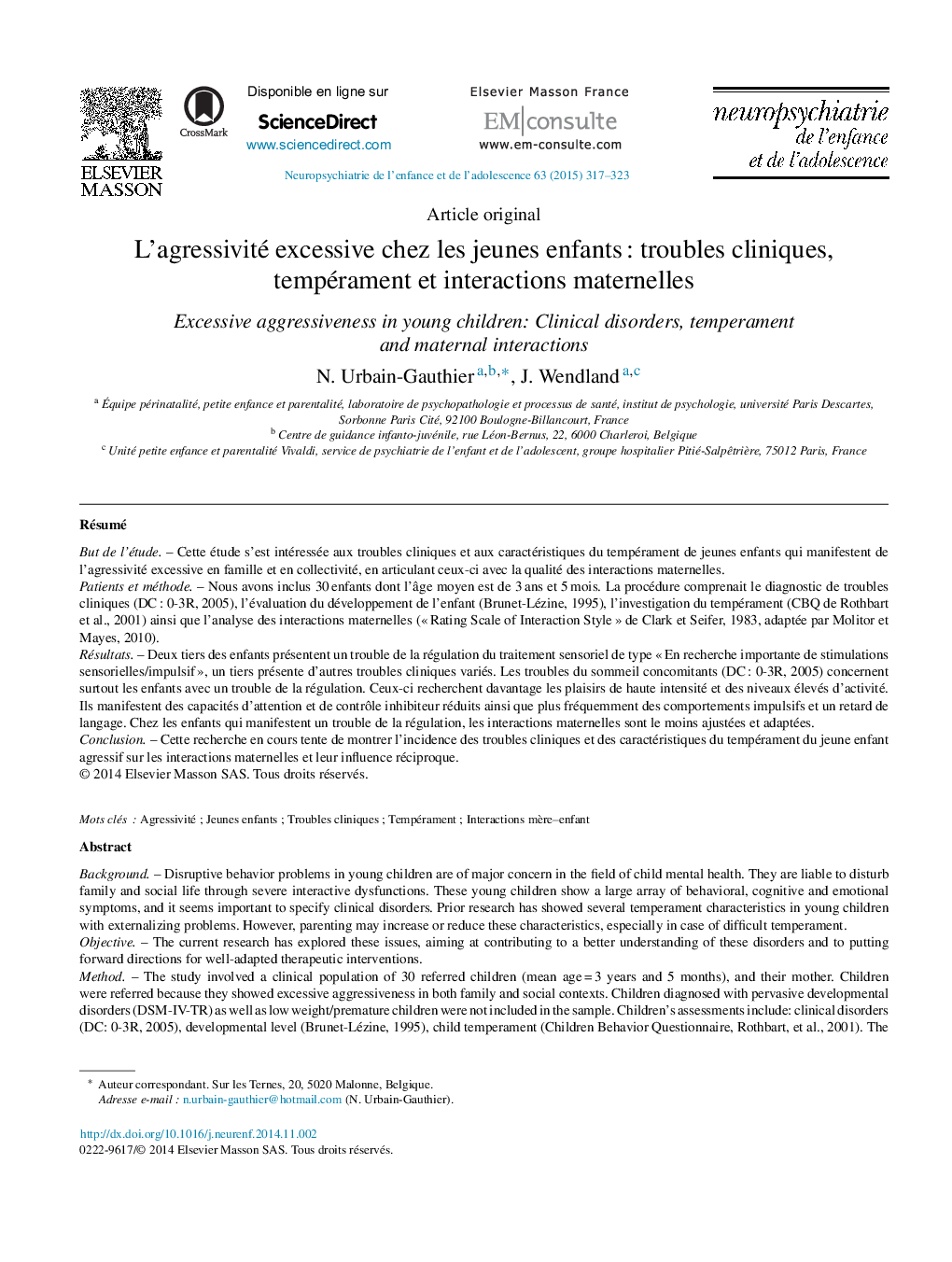| کد مقاله | کد نشریه | سال انتشار | مقاله انگلیسی | نسخه تمام متن |
|---|---|---|---|---|
| 943739 | 925555 | 2015 | 7 صفحه PDF | دانلود رایگان |

RésuméBut de l’étudeCette étude s’est intéressée aux troubles cliniques et aux caractéristiques du tempérament de jeunes enfants qui manifestent de l’agressivité excessive en famille et en collectivité, en articulant ceux-ci avec la qualité des interactions maternelles.Patients et méthodeNous avons inclus 30 enfants dont l’âge moyen est de 3 ans et 5 mois. La procédure comprenait le diagnostic de troubles cliniques (DC : 0-3R, 2005), l’évaluation du développement de l’enfant (Brunet-Lézine, 1995), l’investigation du tempérament (CBQ de Rothbart et al., 2001) ainsi que l’analyse des interactions maternelles (« Rating Scale of Interaction Style » de Clark et Seifer, 1983, adaptée par Molitor et Mayes, 2010).RésultatsDeux tiers des enfants présentent un trouble de la régulation du traitement sensoriel de type « En recherche importante de stimulations sensorielles/impulsif », un tiers présente d’autres troubles cliniques variés. Les troubles du sommeil concomitants (DC : 0-3R, 2005) concernent surtout les enfants avec un trouble de la régulation. Ceux-ci recherchent davantage les plaisirs de haute intensité et des niveaux élevés d’activité. Ils manifestent des capacités d’attention et de contrôle inhibiteur réduits ainsi que plus fréquemment des comportements impulsifs et un retard de langage. Chez les enfants qui manifestent un trouble de la régulation, les interactions maternelles sont le moins ajustées et adaptées.ConclusionCette recherche en cours tente de montrer l’incidence des troubles cliniques et des caractéristiques du tempérament du jeune enfant agressif sur les interactions maternelles et leur influence réciproque.
BackgroundDisruptive behavior problems in young children are of major concern in the field of child mental health. They are liable to disturb family and social life through severe interactive dysfunctions. These young children show a large array of behavioral, cognitive and emotional symptoms, and it seems important to specify clinical disorders. Prior research has showed several temperament characteristics in young children with externalizing problems. However, parenting may increase or reduce these characteristics, especially in case of difficult temperament.ObjectiveThe current research has explored these issues, aiming at contributing to a better understanding of these disorders and to putting forward directions for well-adapted therapeutic interventions.MethodThe study involved a clinical population of 30 referred children (mean age = 3 years and 5 months), and their mother. Children were referred because they showed excessive aggressiveness in both family and social contexts. Children diagnosed with pervasive developmental disorders (DSM-IV-TR) as well as low weight/premature children were not included in the sample. Children's assessments include: clinical disorders (DC: 0-3R, 2005), developmental level (Brunet-Lézine, 1995), child temperament (Children Behavior Questionnaire, Rothbart, et al., 2001). The quality of mother–child interaction was assessed during a videotaped free play sequence, with the Rating Scale of Interaction Style (Clark and Seifer, 1983, adapted by Molitor and Mayes, 2010).ResultsTwo thirds of the referred children show a regulation disorder of sensory processing, sensory stimulation-seeking/impulsive type. The fifth of the children show disorders of affect and the remaining children were diagnosed with diverse clinical disorders. Children with a regulation disorder showed concomitant sleep behavior disorders, mostly sleep-onset disorders. They also showed more difficulties in temperamental characteristics, such as attentional focusing, inhibitory control, and impulsivity than children with other clinical disorders. They presented also more often a language's delay. As for the mothers of children with regulation disorder, they showed lower levels of facilitative positioning, interest in engagement, adaptation and awareness of the child's actions, than mothers of children with others clinical disorders. They attempted to interrupt and to intrude on the child's activity more frequently and showed more negative affect than other mothers. Thus, mothers of children with regulation disorder displayed more maladaptive interactions than mothers of children with other clinical disorders. With regard to child's play, responsiveness, opposition attitude, negative and positive affect towards the mother were not different between children with regulation disorder, and children with other clinical disorders. Maladaptive interactions of mothers of group 1 do not seem to be due neither to children's opposition attitude and negative affect nor to their lack of interest in interaction with the mother during the free play sequence.ConclusionThis study attempts to show the effect of clinical disorders and temperamental characteristics on maternal interactions, and their mutual influence.
Journal: Neuropsychiatrie de l'Enfance et de l'Adolescence - Volume 63, Issue 5, August 2015, Pages 317–323